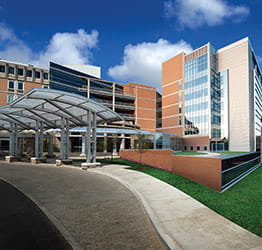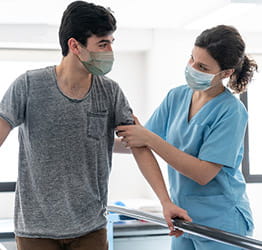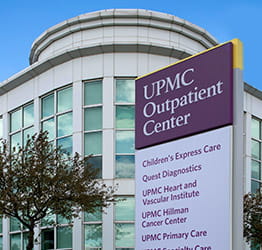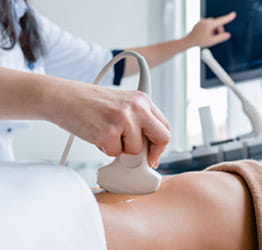Hemorrhagic stroke — also called a brain bleed — is a life-threatening condition that occurs when a blood vessel in your brain breaks and blood leaks into your brain tissue. This bleeding results in swelling, increased pressure in your skull, and tissue damage that causes brain cells in the affected area to die.
Hemorrhagic strokes are less common than ischemic strokes, which happen when blood flow to the brain is blocked. However, both types of stroke cause similar symptoms and require emergency treatment to reduce the risk of permanent disability and death.
At UPMC, our neurosurgery experts offer a full range of nonsurgical, minimally invasive, and traditional open surgical procedures to treat hemorrhagic stroke. After diagnosing your condition and finding the cause of the bleeding, our neurosurgeons will develop a comprehensive treatment plan to reduce your risk of complications and give you the best chance of recovery.
On this page
What Is Hemorrhagic Stroke?
Hemorrhagic stroke — also called a brain bleed — is a life-threatening condition that occurs when a blood vessel in your brain breaks and blood leaks into your brain tissue. This bleeding results in swelling, increased pressure in your skull, and tissue damage that causes brain cells in the affected area to die.
Hemorrhagic strokes are less common than ischemic strokes, which happen when blood flow to the brain is blocked. However, both types of stroke cause similar symptoms and require emergency treatment to reduce the risk of permanent disability and death.

What are the types of hemorrhagic stroke?
There are four common types of hemorrhagic stroke, including:
- Arteriovenous malformation (AVM) — Happens when the arteries and veins in your brain are tangled, or malformed, from birth. Over time, the AVM may break apart (rupture), causing bleeding in your brain.
- Cerebral amyloid angiopathy (CAA) — More common in older people, CAA happens when small blood vessels in your brain are weakened by deposits of a protein called amyloid. These weakened arteries can rupture and cause bleeding in your brain.
- Intracerebral hemorrhage (ICH) — Happens when a small artery in your brain ruptures and blood leaks into nearby brain tissue. It is usually caused by high blood pressure.
- Subarachnoid hemorrhage (SAH) — Happens when a large artery becomes weak and develops a bulge called an aneurysm that eventually ruptures. When the aneurysm breaks, blood spills into the space between your brain tissue and the arachnoid membrane that covers your brain.
What causes hemorrhagic stroke?
Hemorrhagic stroke may be caused by conditions including:
What are hemorrhagic stroke risk factors and complications?
Hemorrhagic stroke risk factors
Hemorrhagic stroke is more common in older people but can happen at any age. You may be at higher risk of hemorrhagic stroke if you:
- Have a head injury.
- Have diabetes.
- Have high blood pressure.
- Have high cholesterol.
- Have a family history of hemorrhagic stroke.
- Have a history of migraine headaches, especially with aura.
- Smoke.
- Take blood-thinning medications.
- Use alcohol heavily.
- Use recreational drugs.
Complications of hemorrhagic stroke
A hemorrhagic stroke is a life-threatening emergency that can lead to disability or death without fast treatment.
Because hemorrhagic stroke damages the part of the brain where the bleeding occurs, it can lead to loss or impairment of the functions controlled by that part of the brain. For example, if you have a hemorrhagic stroke in the part of your brain that controls speech, your ability to speak may be affected.
How can I prevent hemorrhagic stroke?
You can reduce your risk of hemorrhagic stroke by:
- Avoiding recreational drugs.
- Controlling high blood pressure.
- Limiting alcohol.
- Quitting smoking.
- Reducing your risk of head injury.
How common is hemorrhagic stroke?
According to the American Stroke Association, hemorrhagic strokes make up about 13 percent of all stroke cases.
Back to top.
What Are the Signs and Symptoms of Hemorrhagic Stroke?
Symptoms of hemorrhagic stroke can occur suddenly or gradually and depend on the location of the hemorrhage. Symptoms may include:
- Difficulty speaking or understanding speech.
- Loss of consciousness.
- Nausea.
- Seizures.
- Severe headache, which may worsen with changes in your body position.
- Stiff neck muscles.
- Vision loss or disturbances.
- Vomiting.
- Weakness, numbness, tingling, or paralysis in your face, arm, or leg, usually on one side of the body only.
When should I see a doctor about my hemorrhagic stroke symptoms?
A hemorrhagic stroke is life-threatening and needs emergency treatment. If you have symptoms of a hemorrhagic stroke, dial 911 right away — don’t wait. Getting fast treatment can reduce your risk of disability and death.
Back to top.
How Do You Diagnose Hemorrhagic Stroke?
To diagnose hemorrhagic stroke, your doctor will perform a physical exam and order imaging tests.
What to expect during your visit
When you arrive at the hospital, your doctor will:
- Perform a physical exam.
- Order imaging or other tests.
- Review your health history and medications.
Tests to diagnose hemorrhagic stroke
Your doctor may order imaging tests to diagnose hemorrhagic stroke, including:
- CT or MR angiogram — A test that uses x-rays or magnets and a special contrast dye to look for damage to the blood vessels in your brain.
- CT scan — A test that creates images of your brain and is used to diagnose stroke, brain aneurysm, or another type of brain injury.
- MRI — Uses a combination of large magnets, radio frequencies, and a computer to produce detailed images of your brain.
Hemorrhagic stroke prognosis
Hemorrhagic stroke is a life-threatening condition. Your prognosis after a hemorrhagic stroke will depend on the severity of the bleeding, what part of your brain is affected, and how quickly you receive medical care.
What can I expect for hemorrhagic stroke recovery?
Your recovery after a hemorrhagic stroke will depend on the amount of brain damage you experienced and the symptoms you have. Some people have no deficits after a stroke and can resume their normal activities, but others experience severe side effects that cause loss of independence.
Side effects after stroke may include:
- Cognitive problems with thinking, reasoning, or judgement.
- Difficulty swallowing, speaking, or understanding speech.
- Incontinence.
- Memory problems.
- Mood disorders, such as depression, anxiety, or mood swings.
- Pain, numbness, or tingling.
- Problems with balance or coordination.
- Trouble regulating emotions and emotional outbursts.
- Vision problems.
- Weakness, paralysis, or problems with movement.
You may need inpatient or outpatient physical, occupational, or speech therapy after your stroke to help improve or manage side effects. Some people may experience improvement in their side effects over time as their brain begins to heal, but other people may have permanent disability.
Back to top.
How Do You Treat Hemorrhagic Stroke?
The goals of hemorrhagic stroke treatment are to control bleeding and prevent permanent brain damage that can lead to death and disability. Treatment for hemorrhagic stroke depends on:
- The location, extent, and duration of your bleeding.
- Your overall condition.
Treatment may include:
Nonsurgical treatment with medication
If you have minimal symptoms and are not a candidate for surgery, your doctor may recommend medications to:
- Control blood pressure.
- Help your blood clot more quickly to reduce bleeding.
- Measure and manage pressure inside your skull.
- Reduce swelling.
- Treat symptoms, such as headache or seizures.
Minimally invasive surgery for hemorrhagic stroke
UPMC surgeons perform minimally invasive procedures to treat hemorrhagic stroke by draining blood from the affected area of the brain and repairing the source of the bleeding.
These procedures can be performed through a small incision in the scalp or using a catheter that is inserted into a blood vessel and guided to the site of the brain bleed. Procedures include:
- Aneurysm clipping — Involves placing a metal clip around the base of an aneurysm to control bleeding.
- Embolization — Blocks blood flow to abnormal blood vessels, including AVMs.
- Endoscopic evacuation — Uses a small instrument with a camera to remove blood clots from the brain.
- Endovascular coiling — Uses small coils to block blood flow to an aneurysm.
- External ventricular drain (EVD) — Uses a thin, flexible tube called a catheter to drain fluid and blood from the brain.
- Flow diverters — Uses small devices to block blood flow to an aneurysm.
- Stereotactic aspiration — Uses imaging guidance and small surgical instruments to remove blood clots from the brain.
Surgery for hemorrhagic stroke
If you are not a candidate for a minimally invasive procedure, your doctor may recommend a procedure called a craniotomy to treat your hemorrhagic stroke. It involves removing a piece of your skull to access your brain, drain excess fluid and blood, and control bleeding.
Why choose UPMC for hemorrhagic stroke care?
When you choose UPMC for hemorrhagic stroke care, you will receive:
- Access to world-class neurosurgery expertise —Our world-renowned experts treat the full spectrum of neurosurgical conditions using the latest diagnostic and treatment techniques.
- A full range of treatment options — We offer nonsurgical care, as well as minimally invasive and traditional open surgical procedures, allowing us to effectively treat all types of disorders while reducing your risk of complications.
- Multidisciplinary care — We partner with neurologists, rehabilitation specialists, and other medical experts to provide complete care that optimizes your recovery and quality of life.
Back to top.
By UPMC Editorial Staff. Last reviewed on 2025-10-23.

















